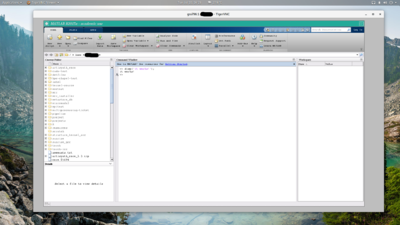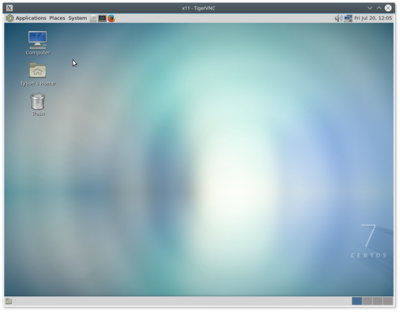VNC
It is sometimes useful to start a graphical user interface for certain software packages (like MATLAB for example). The most widely-available way to do this is with SSH and X11 forwarding, but the performance of SSH+X11 is often too slow to be useful. An alternative is to use VNC to start and connect to a remote desktop.
VNC Client
First you will need to install a VNC client on your machine to connect to the VNC server. We recommend using TigerVNC. A TigerVNC package is available for most Linux distributions, as are binaries for Windows and Mac.
Windows and Mac
Starting at the TigerVNC home page
- click on the GitHub release page link
- scroll down and click on the Binaries are avaiable from bintray link
- scroll down and pick the .exe file for Windows (note the 64 for 64 bit Windows) or the .dmg file for Mac
If asked during the installation, do not enable the VNC server or start the VNC service. This is for sharing your desktop, not for connecting to our systems.
Linux
Install the TigerVNC viewer with your package manager and then symlink ~/.vnc/x509_ca.pem to your system certificate authority list.
Debian or Ubuntu
[name@local_computer]$ sudo apt-get install tigervnc-viewer
[name@local_computer]$ mkdir ~/.vnc
[name@local_computer]$ ln --symbolic --interactive --no-target-directory /etc/ssl/certs/ca-certificates.crt ~/.vnc/x509_ca.pem
Fedora, CentOS, or RHEL
[name@local_computer]$ sudo yum install tigervnc
[name@local_computer]$ mkdir ~/.vnc
[name@local_computer]$ ln --symbolic --interactive --no-target-directory /etc/pki/tls/certs/ca-bundle.crt ~/.vnc/x509_ca.pem
Gentoo
[name@local_computer]$ emerge -av net-misc/tigervnc
[name@local_computer]$ mkdir ~/.vnc
[name@local_computer]$ ln --symbolic --interactive --no-target-directory /etc/ssl/certs/ca-certificates.crt ~/.vnc/x509_ca.pem
MacOS
[name@local_computer]$ install latest TigerVNC-1.9.0.dmg
[name@local_computer]$ mkdir ~/.vnc
[name@local_computer]$ ln -s /etc/ssl/cert.pem ~/.vnc/x509_ca.pem
VNC Server
Now you need a VNC server to connect to. This can be either the dedicated VDI login system on Graham, or one you start manually on an allocated compute node.
VDI Login Nodes
Graham has dedicated VDI login nodes that provide a full graphical desktop, accelerated OpenGL, and access to /home, /project, and /scratch filesystems. You can connect to one of the VNC login nodes directly by starting your VNC viewer and entering the address gra-vdi.computecanada.ca. With TigerVNC, this means start the client from your Applications menu or run vncviewer from the command line. This will bring up a login screen to which you can log in using your Compute Canada credentials.
As with regular login nodes, these VDI login nodes are a shared resource and are not intended for doing batch computation (that is what the compute nodes are for), so please limit your use of them to graphics-related tasks. A non-exclusive list of examples includes graphical pre-processing steps such as mesh generation, graphical post-processing steps such as visualization, and using graphical intergrated development environments (IDEs).
Installing software
Open-source software is provided by the nix module. The nix store on gra-vdi is preconfigured to use accelerated OpenGL whenever possible. To install a nix package into your environment click the black terminal icon on the top menu bar or pick Applications -> System Tools -> Terminal. Once a terminal window appears, run module load nix. Now you can search for programs using the nix search <regexp> command and install them in your environment using the nix-env --install --attr <attribute> command. As an example, say you wanted to install QGIS:
[name@gra-vdi4]$ module load nix
[name@gra-vdi4]$ nix search qgis
Attribute name: nixpkgs.qgis
Package name: qgis
Version: 2.18.20
Description: User friendly Open Source Geographic Information System
[name@gra-vdi4]$ nix-env --install --attr nixpkgs.qgis
Your nix environment persists from one login to the next, therefore you only need to run an install command once. Whatever you install today will be available anytime you load the nix module.
[name@gra-vdi4]$ module load nix
[name@gra-vdi4]$ qgis
Building OpenGL applications
For accelerated OpenGL to work, it is necessary to adjust compiled binaries to pre-load an appropriate version of the "vglfaker.so" library from VirtualGL. This has already been done for software modules available on gra-vdi and any OpenGL based packages you build/install via nix. It is, however, something that has to be done for any pre-built software you download or any codes you compile without using nix.
The easiest way to do this is use the patchelf utility from nix (use nix-env --install --attr nixpkgs.patchelf to install it) to adjust the final binary. For example, say you built an OpenGL application against the system libraries and installed it as ~/.local/bin/myglapp. Then you need to add the system VirtualGL library /usr/lib64/VirtualGL/libvglfaker.so as the first required library to it
[name@gra-vdi4]$ module load nix
[name@gra-vdi4]$ patchelf --add-needed /usr/lib64/VirtualGL/libvglfaker.so ~/.local/bin/myglapp
Note that it is also possible to pre-load vglfaker.so via the LD_PRELOAD environment variable. This is generally a bad idea as it applies indiscriminately to all binaries, and those that require a different vglfaker.so than that set in LD_PRELOAD will then fail, but it can be used safely in some cases in wrapper scripts.
Compute Nodes
Where VDI login nodes are unavailable you can start a VNC server on a compute node, and, with suitable port forwarding, connect to it from your desktop. This gives you dedicated access to the server, but does not provide a full graphical desktop or hardware-accelerated OpenGL.
Starting a VNC server
Before starting your VNC server, reserve a node on which to run it using salloc. As an example, to request an interactive job using 4 CPUs and 16GB of memory you could use the command:
[username@cedar5:~/project] salloc --time=1:00:0 --cpus-per-task=4 --mem=16000 --account=def-username
salloc: Pending job allocation 20067316
salloc: job 20067316 queued and waiting for resources
salloc: job 20067316 has been allocated resources
salloc: Granted job allocation 20067316
salloc: Waiting for resource configuration
salloc: Nodes cdr768 are ready for job
[username@cdr768:~/project]
Once your interactive job has started, start a VNC server with vncserver. Take note of which node your job is running on. If unsure, you can use the hostname command to check. The first time you do this you will be prompted to set a password for your VNC server. DO NOT LEAVE THIS BLANK. You may change it later using the vncpasswd command. Continuing with the example:
[username@cdr768:~/project] vncserver
You will require a password to access your desktops.
Password:
Verify:
Would you like to enter a view-only password (y/n)? n
xauth: file /home/username/.Xauthority does not exist
New 'cdr768.int.cedar.computecanada.ca:1 (username)' desktop is cdr768.int.cedar.computecanada.ca:1
Creating default startup script /home/username/.vnc/xstartup
Creating default config /home/username/.vnc/config
Starting applications specified in /home/username/.vnc/xstartup
Log file is /home/username/.vnc/cdr768.int.cedar.computecanada.ca:1.log
Determine which port the VNC server is using by examining the log file:
[username@cdr768:~/project] grep port /home/username/.vnc/cdr768.int.cedar.computecanada.ca:1.log
vncext: Listening for VNC connections on all interface(s), port 5901
Setting up an SSH tunnel to the VNC server
Once your VNC server has been started, create a "bridge" to allow your local desktop computer to connect to the compute node directly. This bridge connection is created using an SSH tunnel. SSH tunnels are created on your computer using the same SSH connection command as usual, with an extra option added - this follows the format: ssh user@host -L port:compute_node:port.
An example of an SSH tunnel command run on your computer to connect to a VNC server running on Graham's gra796 node and port 5901 would be the following:
ssh username@cedar.computecanada.ca -L 5902:cdr767:5901
The SSH tunnel operates like a normal SSH session: You may run commands over it, etc. However, keep in mind that this SSH session is also your connection to the VNC server. If you terminate the SSH session, your connection to the VNC server will be lost! For more information, please see SSH tunnelling.
Connecting to the VNC server
To connect to the VNC server, you need to tell your VNC client to connect to localhost. The following example uses TigerVNC's vncviewer to connect to the running VNC server on cdr767. You will be prompted for the VNC password that you set earlier in order to connect.
Command with sample output:
[name@local_computer]$ vncviewer localhost:5902
TigerVNC Viewer 64-bit v1.8.0
Built on: 2018-06-13 10:56
Copyright (C) 1999-2017 TigerVNC Team and many others (see README.txt)
See http://www.tigervnc.org for information on TigerVNC.
Tue Jul 10 17:40:24 2018
DecodeManager: Detected 8 CPU core(s)
DecodeManager: Creating 4 decoder thread(s)
CConn: connected to host localhost port 5902
CConnection: Server supports RFB protocol version 3.8
CConnection: Using RFB protocol version 3.8
CConnection: Choosing security type VeNCrypt(19)
CVeNCrypt: Choosing security type TLSVnc (258)
Tue Jul 10 17:40:27 2018
CConn: Using pixel format depth 24 (32bpp) little-endian rgb888
CConn: Using Tight encoding
CConn: Enabling continuous updates
The port number (here 5902) must match the local port (the first number) you specified when you set up the SSH tunnel. The default VNC port is 5900. If you specified 5900 for the local port of the SSH tunnel, you could omit it when you invoke vncviewer. However, Windows users may find that they cannot set up an SSH tunnel on local port 5900.
Once connected, you will be presented with an Xterm window and a blank desktop. To launch a program, simply invoke the command as you would normally within the Xterm window. xclock will start a sample clock application you can use to test things out. To start a more complicated program like MATLAB, load the module and launch the program as follows:
[name@server ~]$ module load matlab
[name@server ~]$ matlab
Locked MATE desktop
If you are running MATE desktop environment inside your VNC session and find it locked, you can kill the screensaver on the node where your VNC session is running:
[name@server ~]$ killall -9 .mate-screensav
Resetting your VNC server password
If you forget your VNC password or otherwise want to delete your VNC configs and start over with a clean slate, you can delete your ~/.vnc directory. The next time you run vncserver, you will be prompted to set a new password.

